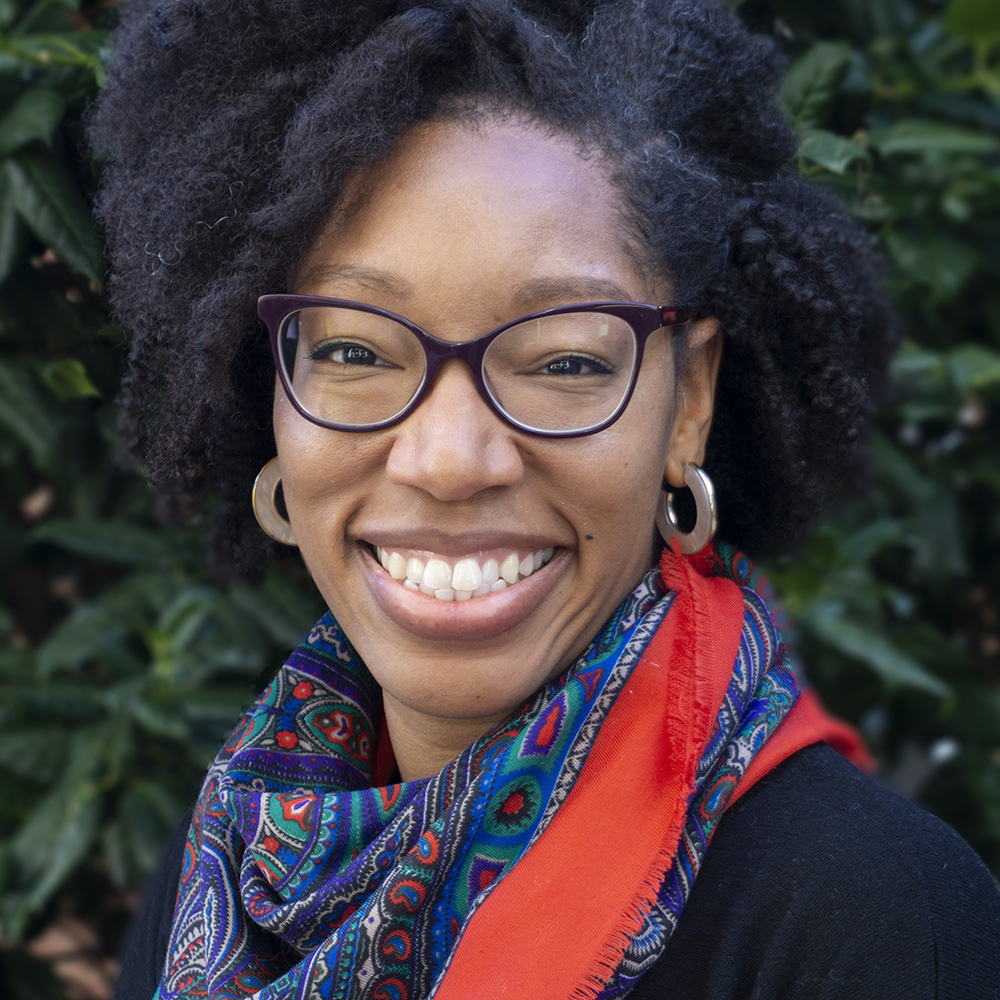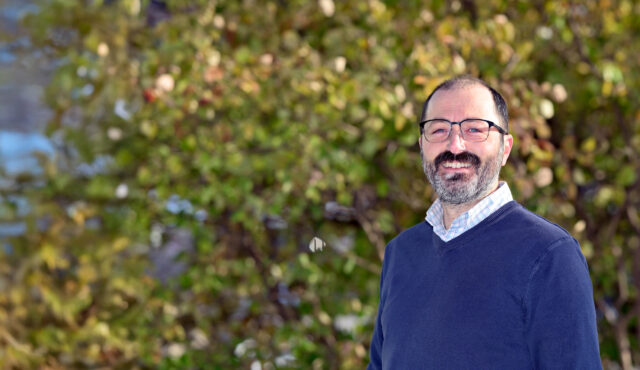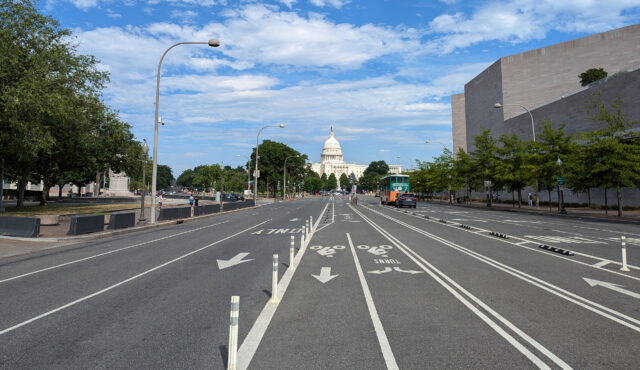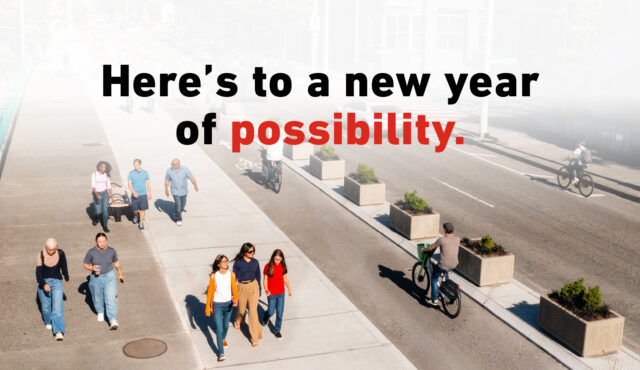We are celebrating 20 years of Toole Design this year by taking on the topics that will define our industry over the next 20 years. We hope to spark collective action to create safer, healthier, more just communities. (See subsequent articles in this series on gentrification and displacement, on climate change, and on the future of transit.)
The transportation world looks quite different than it did twenty years ago when Toole Design was founded, and it will likely look dramatically different in another twenty years. Our vision for the future starts with a safe, just, and resilient transportation system that enables people to thrive; a system that creates community and a sense of place.
Our vision for 2043
- There are no traffic fatalities in the United States and Canada.
- The transportation sector is carbon neutral.
- Public rights-of-way and the public realm are barrier free.
- The transportation system contributes to a more just society.
Significant changes to the status quo are necessary, starting today, if we are to realize these (and other) dramatic headlines by 2043. We are undertaking a series of internal conversations to identify ways in which we can ensure different outcomes from transportation investments in communities. We can’t stop there, however. Our goal is to influence the way our industry does business by bringing together the ideas and experience of some of the most forward-thinking professionals in our sector.
Our conversations so far have pinpointed three major areas to address: Gentrification and Displacement, Climate Change, and Transit and New Mobility. These are not discrete areas—they overlap and intertwine in many ways, and they warrant overlapping and intertwining solutions. They are also not new topics—we have identified numerous existing resources and examples below that demonstrate the progress we have already made in these areas.
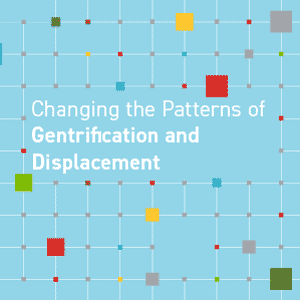
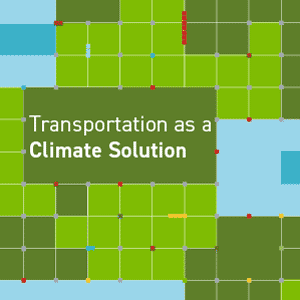
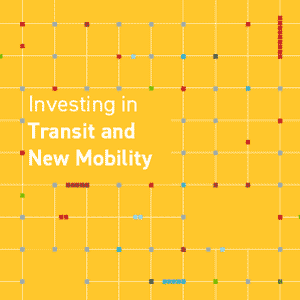
Why these three topics? Simply put, we are not going to substantially reduce carbon emissions, crashes, and barriers to access in our transportation system without a massive shift towards transit and new mobility. So how are we going to start that shift, and how are we going to do it while preventing greater gentrification and displacement? Are communities ready to embrace and implement the kinds of holistic, multi-functional solutions necessary to prevent and adapt to climate change, such as a huge increase in active travel? If not, what do we need to do today to start changing that situation?
“These are the big questions we need to ask ourselves as a company,“ says Andy Clarke, Director of Strategy. “And to the extent possible, we need the entire transportation industry to be addressing the same issues as soon as possible.”
Over the course of this year, we will share the ideas we gather across these three themes and provide actionable steps to realize our vision by 2043, if not sooner.
Changing the Patterns of Gentrification and Displacement
of decades of disinvestment) are actually able to benefit from them.”
Legitimate fears around gentrification and displacement highlight structural inequities across society that are frequently revealed in transportation and land use decisions, policies, and projects. As planners, policymakers, and consultants, what steps can we take to build policies, programs, and projects that provide access to jobs and services, and both reconnect and create wealth in communities that have experienced disinvestment in the past?
here’s What’s working:
- Equitable engagement techniques. Check out our Resource Guide on rebalancing streets, in this Planning Magazine article co-authored by Toole Design staff, and in this engagement toolkit we developed for the East Central Wisconsin Regional Planning Commission.
- Holistic, multi-sector approaches that bring together transportation, housing, and land use concerns. Good examples include this year’s Smart Growth America Equity Summit and during this webinar on housing, parking, and transportation policy featuring Toole Design’s Quinn Kelly.
- Continued listening and learning. Over 50 staff members at Toole Design are currently participating in a book club on Gentrification is Inevitable and Other Lies by Leslie Kern.
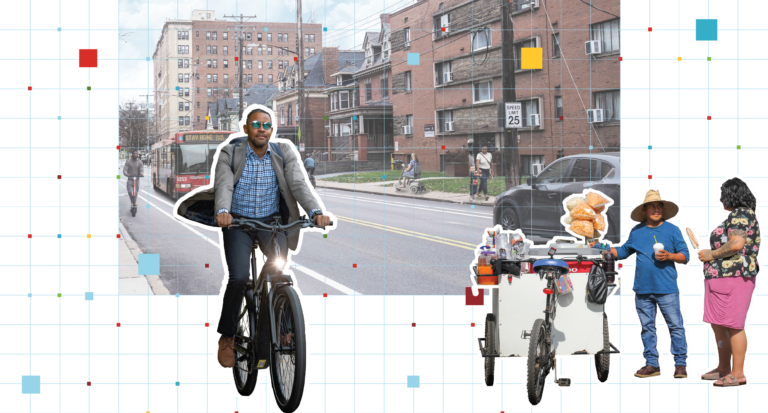
Transportation as a Climate Solution
We need meaningful change in our industry and society to make the necessary adaptations to climate change—and we have no time to lose. What are the actions we can prioritize now to evolve the transportation industry into a force for planetary good? And what is the role of Toole Design and our partners in that evolution?
here’s What’s working:
- Landscape architects leading transportation projects. Embed green infrastructure into design and construction to create climate resilient transportation systems. We took this approach with the Reimagine Russell Boulevard project in Davis, CA. Currently, we are completing a plan to mitigate the effects of climate change for pedestrians, for the Minnesota Department of Transportation, which includes both policy recommendations and engagement tactics to promote the value and versatility of green infrastructure.
- Harnessing the power of trails. The new FHWA Trails as Resilient Infrastructure Guidebooks explores how trail corridors can be part of the climate solution. Our Bay Trail Equity Strategy demonstrates how racial equity needs to be central to trail development and climate justice in general.
- Containing sprawl. The Driving Down Emissions report from Smart Growth America, along with a new report from RMI, show how land use reform has the power to reduce vehicle miles traveled, greenhouse gas emissions, and energy use in metro areas.
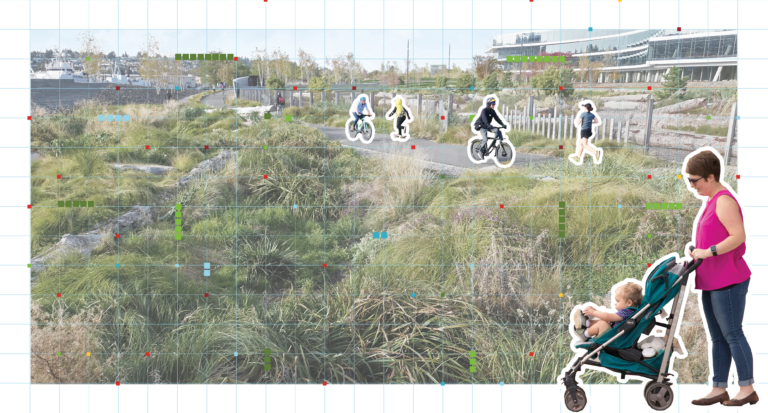
Investing in Transit and New Mobility
A transportation system that centers transit and new mobility (e-bikes, bikeshare, e-scooters, and other small conveyances) has the power to change the world—if attitudes and investment in transportation in the United States and Canada can shift dramatically. We know that a massive increase in transit use, as well as new mobility and the infrastructure to support it, is necessary to help achieve Vision Zero and a carbon neutral transportation sector. How can we help to quickly redefine transportation priorities in North America?
here’s What’s working:
- Transit-oriented development (TOD) and transit-supportive land uses. An intentional transit strategy, like the one we developed for Heritage Heights in Brampton, ON as a proposed highway alternative, can contribute to increased use of transit and more effective spaces for social and economic exchange.
- Inclusive, multimodal approaches. The latest guidance, as represented by the Ohio Multimodal Design Guide, emphasizes the importance of connecting different modes. For instance, it includes sections on the connections and transitions between active transportation facilities and transit.
- Taking micromobility seriously. The use of small conveyances such as e-bikes and e-scooters shows no sign of slowing down. These modes can fill transit gaps and lead to mode shifts in otherwise car-dependent communities. Toole Design develops the annual NABSA State of the Industry report, which assesses trends at the ground level and at the policy level. Mobility hubs, like those we piloted for the City of Boston, create vital transition points where people can connect across modes.
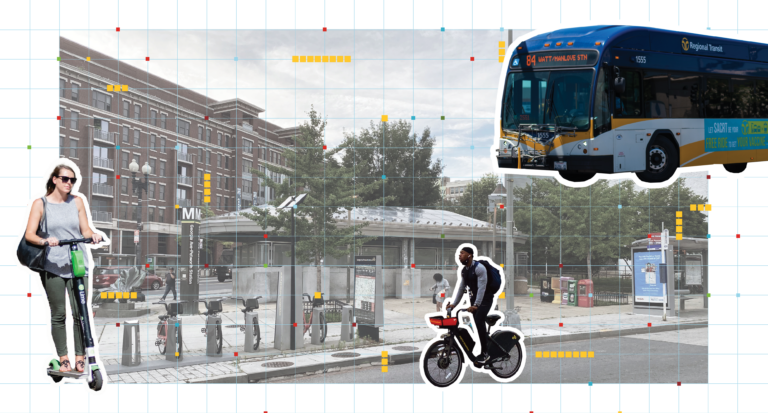
Putting It All Together
We are proud to count some of the brightest minds in transportation among our staff here at Toole Design. As they focus on these challenges in the coming months, their depth of knowledge and breadth of experience will no doubt yield the type of bold-yet-practical solutions that they deliver for clients every day.
But we cannot do it alone. It is the responsibility of no individual person, agency, or firm to transform an industry. It’s on all of us, and we know that many of our colleagues and partners think and care deeply about these issues as well.
Imagining a future into being is a collective act. We are excited to continue these internal conversations and engage with our partners to encourage bold and necessary changes. We certainly don’t have all the answers yet, but we look forward to expanding our portfolio of projects in these areas, and are eager to hear about game-changing projects from readers.
Here’s to putting our heads, hearts, and voices together to design the path to the 2043 we all want to see.
